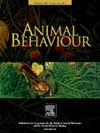无论性别比例如何,雌性沙虾虎鱼的黑眼表现随雄性的注意力和筑巢而变化
IF 2.1
2区 生物学
Q2 BEHAVIORAL SCIENCES
引用次数: 0
摘要
在性别选择下,究竟是什么因素促进了女性装饰物的进化,我们知之甚少。沙虾虎鱼(Pomatoschistus minutus)是一种小型海洋鱼类,雌性虾虎鱼非常隐蔽,除了眼睛附近有一种非常明显的黑色色素,即短暂的“黑眼睛”。筑巢的雄鸟为吸引配偶而表现出婚色和求爱,但没有黑色的眼睛。这种女性特征的功能尚不清楚。本研究旨在探讨成虫性别比例是否会影响雌性沙虾虎鱼黑眼现象的发生、持续时间或潜伏期。两种反映自然条件的成人性别比处理(男性偏见:3名女性,4名男性;女性偏倚:3名女性,2名男性)。我们预测在雌性偏向的成年性别比例下,如果其主要功能与性内竞争有关,则显示频率更高或更长。我们发现成人性别比例对显示的发生、持续时间或延迟没有显著影响。然而,相对较圆的雌性显示的时间更长,这意味着它可能表明了产卵的意图。一直以来,产卵更有可能发生在观察到深色眼睛的复制中。此外,质量更好的巢穴与更频繁的黑眼显示有关,这表明巢穴质量影响了显示,或者显示鼓励了更多的雄性投资筑巢。深色眼睛的雌性也比深色眼睛的雌性更能得到雄性的关注。总之,我们的研究结果表明,展示的功能更多地与两性之间的交流有关,而不是与雌性之间的竞争有关。然而,需要进一步的研究来探索它在多大程度上被男性在配偶选择中使用,从而影响它是否应该被称为装饰品。本文章由计算机程序翻译,如有差异,请以英文原文为准。
Female dark eye display in sand gobies covaries with male attention and nest building, regardless of sex ratio
Little is known about what factors promote the evolution of female ornaments under sexual selection. In the sand goby, Pomatoschistus minutus, a small marine fish, females are very cryptic, except for a temporary ‘dark eye’ display, a highly conspicuous black pigmentation near the eyes. Nest-building males show nuptial coloration and courtship to attract mates but no dark eyes. The function of this female trait remains unknown. This study aimed to investigate if the adult sex ratio affects the occurrence, duration or latency of dark eye displays in female sand gobies. Two adult sex ratio treatments that reflect natural conditions (male bias: 3 females, 4 males; female bias: 3 females, 2 males) were used. We predicted more frequent or longer displays under female-biased adult sex ratio if its main function relates to intrasexual competition. We found no significant effect of adult sex ratio on the occurrence, duration or latency of the display. However, relatively rounder females displayed for longer, implying it may signal spawning intent. Consistently, spawning was more likely to happen in replicates in which a dark eye display was observed. Furthermore, better quality nests were associated with a higher frequency of dark eye displays, suggesting that nest quality affects the display or that the display encourages more male investment in nest building. Dark-eyed females also received more attention from males than nondisplaying females. Together, our results suggest the function of the display is related more to communication between the sexes than to competition among females. However, further research is needed to explore to what extent it is used by males in mate choice, affecting whether it should be called an ornament.
求助全文
通过发布文献求助,成功后即可免费获取论文全文。
去求助
来源期刊

Animal Behaviour
生物-动物学
CiteScore
4.60
自引率
8.00%
发文量
236
审稿时长
10.2 weeks
期刊介绍:
Growing interest in behavioural biology and the international reputation of Animal Behaviour prompted an expansion to monthly publication in 1989. Animal Behaviour continues to be the journal of choice for biologists, ethologists, psychologists, physiologists, and veterinarians with an interest in the subject.
 求助内容:
求助内容: 应助结果提醒方式:
应助结果提醒方式:


